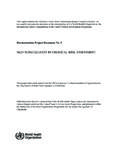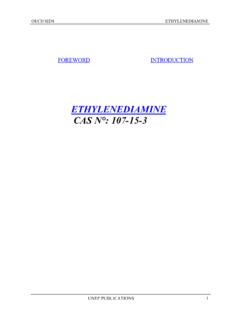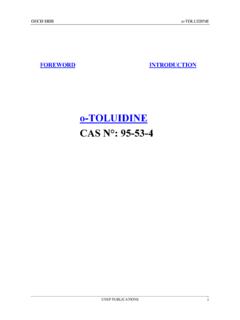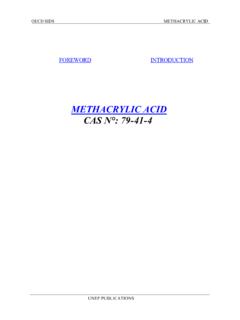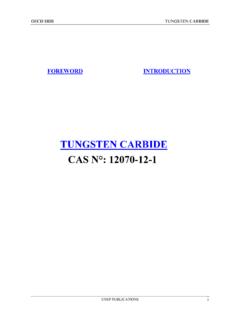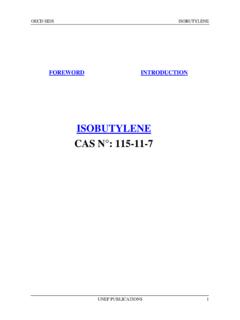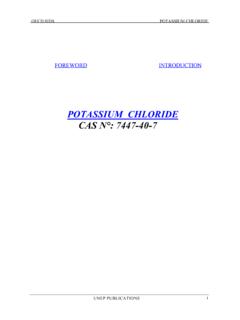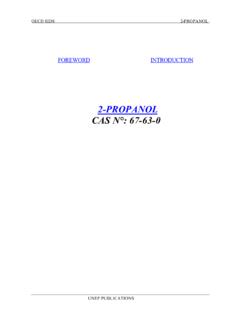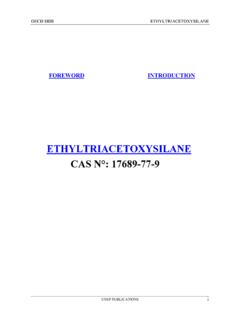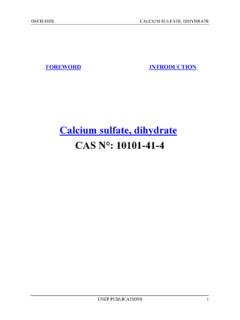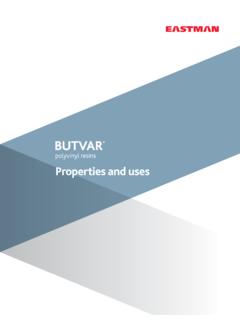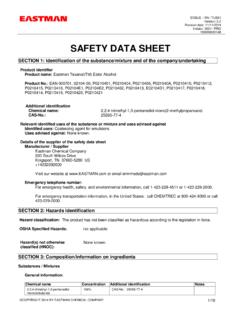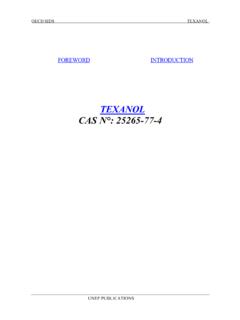Transcription of (MIXED ISOMERS AND DOMINANT ISOMER) CAS …
1 OECD SIDSDIPROPYLENE GLYCOLUNEP PUBLICATIONS1 FOREWORDINTRODUCTIONDIPROPYLENE GLYCOL (MIXED ISOMERS AND DOMINANT ISOMER) CAS N :25265-71-8 & 110-98-5)OECD SIDSDIPROPYLENE GLYCOLUNEP PUBLICATIONS2 SIDS Initial Assessment Reportfor11th SIAM(USA, January 23-26, 2001)Chemical Name:Dipropylene glycol, mixed ISOMERS and DOMINANT isomerCAS No:25265-71-8 and 110-98-5 Sponsor Countr SIDS Contact Point in Sponsor Country:Oscar HernandezUS EPA401 M St., SWWashington , DC 20460 HISTORY:At SIAM 11 the recommendation of Low Priority for Further Work was agreed.
2 Revisions to the SIAR and preparation of Robust Summaries were requested and :Deadline for circulation:Date of Circulation:OECD SIDSDIPROPYLENE GLYCOLUNEP PUBLICATIONS3 SIDS INITIAL ASSESSMENT PROFILECAS -71-8 and 110 -98-5 Chemical Name Dipropylene glycol, mixed ISOMERS and DOMINANT isomerStructural FormulaCH3-CHOH -CH2O-CH2-CHOH-CH3 RECOMMENDATIONSThe chemical is currently of low priority for further CONCLUSIONS OF THE SIARH uman HealthDipropylene glycol (DPG) is not acutely toxic by oral (LD50>13 g/kg bw/day from 7 rat studies and g/kg bw/day from a guinea pig study)
3 , dermal (LD50 > 5g/kg bw/day in 2 rabbit studies) or inhalation (no deaths observed in rats and guinea pigs at 6 to 8 g/m3) routes of exposure. DPG is slightly irritating to the skin and eyes of rabbits. Based on human data, DPG is not a skin exposures of rats to DPG did not result in adverse effects at levels up to 5% (estimatedNOAEL is about g/kg bw/day) in drinking water. At about g/kg bw/day (10%), kidney lesions appeared in about 30% of the rats.
4 Results from an OECD 422 combined repeatdose/reproductive/developmental toxici ty test on the structural analogue, tripropylene glycol (TPG), demonstrated a NOAEL of 200 mg/kg bw and a LOAEL of 1000 mg/kg bw for repeated dose toxicity, with increased relative weight for liver and kidney. Metabolic fate data on TPG demonstrates that TPGis readily converted to DPG, PG, and CO2 in rats. Thus, data from TPG are relevant to DPG. DPG did not cause fetal toxicity or teratogenicity in rats (NOAEL = 5 g/kg bw/day) or rabbits (NOAEL = g/kg bw/day).
5 No reproductive studies have been conducted on DPG. However, the structuralanalogues, propylene glycol and TPG, have been tested for reproductive effects and shown to have NOAELs of g/kg bw in mice and 1 g/kg bw in rats, respectively. Thus, the lack of reproductive effects from TPG and the high NOAEL for PG reproductive toxicity indicate that no reproductive effects are expected in animals exposed to DPG, in the absence of maternal toxicity.
6 DPG is not a genetic toxicant based on in vitro (bacterial and mammalian cells in culture) and in vivo (micronucleus) glycol (DPG) is not volatile, but is miscible with water. Air monitoring data are not available, but concentrations of dipropylene glycol in the atmosphere are expected to be extremely low because of its low vapor pressure and high water solubility. Low levels of DPG ( ng/l) in drinking water were reported in one study. It is biodegraded in water and expected to be biodegraded in soil, as indicated by >70% degradation after 28d in a Zahn-Wellens test.
7 It is not expected to bioaccumulate, with measured BCFs between and in fish. Measured aquatic toxicity data on fish and amphibians report toxicity at >5,000 and 3,181 mg/L, respectively. Based on QSAR data for Daphnia and algal toxicity, and the measured data for fish and amphibians, DPG is not expected to be toxic to aquatic organisms except at very high concentrations. Using an assessment factor of 100 and the fish 96-hour LC50, the PNEC is >50 mg/l; if the amphibian data are used, the PNEC is 32 SIDSDIPROPYLENE GLYCOLUNEP PUBLICATIONS4 ExposureDipropylene glycol is produced as a byproduct of the manufacture of propylene glycol.
8 The US production capacity of DPG was 131 million pounds ( kilotonnes) in 1998; the demand was 108 million pounds (49 kilotonnes). DPG is used (percent of demand) as follows: plasticizers, 38 percent; unsaturated polyester resins, 23 percent; cosmetics and fragrances, 10 percent; polyurethane polyols, 8 percent; alkyd resins, 7 percent; miscellaneous, including solvents and functional fluids (specialty de-icers, inks, lubricants), 14 OF FURTHER WORK RECOMMENDEDNo further work is SIDSDIPROPYLENE GLYCOLE UNEP PUBLICATIONS5 FULL SIDS SUMMARYCAS NO: 25265-71-8, Point--NG<-39 C2.
9 2 Boiling Point--NG228-236 g/cm3 at 25 hPa at 20 Coefficient(Log Kow) Solubility--NGMiscible at at 25 : Reduction Potential----ENVIRONMENTAL FATE AND in Water--NGNo hydrolyzable and Distribution--Fugacitymodel Level to air; to water; to soil; to Other TG: EEC-87/302b. OECD TG 301Ca. >70% after 28 days (pre-adapted)b. No , CODO ther TG:APHA 219 BOD5 = 92 mgO2/LCOD = 1840 TG 305 CBCF of (42 days at 3 mg/L)BCF of < (42 days at 3 mg/L) to FishCarassiusauratus24-hr lethality Other TG: APHA 1971LC50 = >5000 mg/L (static) Toxicity to Aquatic Invertebrates(Daphnia)----No to Aquatic Plants Algae----No dataOECD SIDSDIPROPYLENE GLYCOLE UNEP PUBLICATIONS6 CAS NO: 25265-71-8, to MicroorganismsPseudomonas putidaOther TG.
10 LTwS-Nr 10EC10 = 1000 mg/L (static, 18 hr) Toxicity to Fish----No Toxicity to Aquatic Invertebrates (Daphnia)----No to Soil Dwelling Organisms----No to Terrestrial Plants----No to Other Non-Mammalian TerrestrialSpecies (Including Birds)No Data4 . 9 Additional RemarksXenopuslaevisNGLC50 = 3,181 mg/L (48 hr, static) Oral Toxicitya. Ratb. MouseAcutelethality NGa. LD50 = 16,000 mg/kg (est. from mL/kg)b. LD50 = >2, 000 Inhalation ToxicityRat, guinea pigAcutelethalityNGNot lethal: 6000-8000 mg/m3 (aerosol, nominal concentration) Dermal Toxicity RabbitAcutelethalityNGLD50 > 5000 Irritationa.
